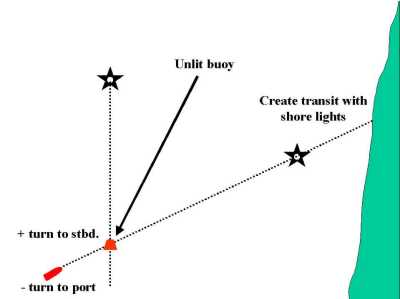Unlit buoys 2.
There are some harbours that buoyed but appear unusable at night because they are unlit.
In suitable conditions it may still be possible to enter those harbours without the use of GPS.
If there are other lights in the area, try plotting a fix on the buoy you wish to find, then starting from a point where the bearing of one of them is correct, travel towards the unlit buoy, keeping the light on the correct bearing.
When the bearing of the other light is correct, stop and you will be close to the buoy you are seeking. Be careful, you may be very close!
There are several tips to make this easier.
- Use lights with a very distinct sequence, white lights can be hard to keep track of if they will be seen against street lights.
- Try to travel with the tide or against it, a cross tide can make this very tricky.
- When you have the first light on the correct bearing, create a transit with the background. This could be with a house or street light or just a distinct point in the pattern of light and dark, it does not need to be a charted light.
- This technique is easiest for the helm to follow if the boat is travelling towards the first light.
- If you draw a picture of the fix on paper and keep it with you on deck it will help. This picture could also include some indication of which side of the correct bearing you are when it does not match the observed one.

This exercise is a favourite one with many Yachtmaster Examiners as it tests your ability to use a hand bearing compass, to identify light sequences, your ability to keep track of what is happening around you and most of all, your ability to think on you feet.
This technique can also be used to avoid an unlit buoy, just make sure you do not arrive at the point where the two bearings meet!
Sailtrain.co.uk is free to use, but if you feel you would like to contribute to the running and development costs you can donate via Paypal:

